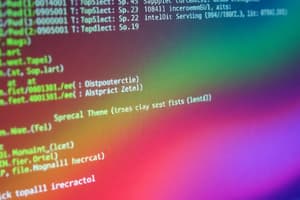Podcast
Questions and Answers
Which system call is used to create a new process?
Which system call is used to create a new process?
- wait
- fork (correct)
- exec
- pid
What is the purpose of the umask access?
What is the purpose of the umask access?
- To create hard links between files
- To rename a file
- To set default permissions for new files and directories (correct)
- To change the ownership of a file
What does the /etc/passwd file contain?
What does the /etc/passwd file contain?
- A list of system users (correct)
- A list of system processes
- A list of system files
- A list of system groups
What is the purpose of the setbuf function?
What is the purpose of the setbuf function?
What is a zombie process?
What is a zombie process?
What is the purpose of the readdir function?
What is the purpose of the readdir function?
What is the purpose of the inode in a UNIX file system?
What is the purpose of the inode in a UNIX file system?
What is the effect of setting the Set UID bit on a file?
What is the effect of setting the Set UID bit on a file?
What is the purpose of the dirname function in the Standard I/O Library?
What is the purpose of the dirname function in the Standard I/O Library?
What is the significance of the /etc/group file?
What is the significance of the /etc/group file?
What is the purpose of the gettimeofday function?
What is the purpose of the gettimeofday function?
What is the result of calling the fork function?
What is the result of calling the fork function?
What is the purpose of the waitpid function?
What is the purpose of the waitpid function?
What is the purpose of the pipe function in interprocess communication?
What is the purpose of the pipe function in interprocess communication?
What is the purpose of the chmod function?
What is the purpose of the chmod function?
What is the significance of the utimes function?
What is the significance of the utimes function?
Flashcards are hidden until you start studying
Study Notes
Files and Directories
- A UNIX file system consists of disk partitions
- File types and directory entries are stored as (name, inode-number) pairs
- Links can be hard (inode: data stored and access to file data via direct and indirect blocks) or symbolic
- Ownership of a file can be viewed using stat, fstat, and lstat commands, with permissions for user/group/other
- Set UID and Set GID bits can be set, and access control can be modified using umask, chmod, and fchmod commands
- Files can be managed using chown, fchown, link, unlink, rename, and utimes commands
- Directories can be managed using mkdir, rmdir, chdir, and fchdir commands
- File descriptors can be manipulated using opendir, closedir, readdir, telldir, seekdir, and rewinddir commands
Standard I/O Library
- Standard input, output, and error streams (stdin, stdout, stderr) can be buffered, line-buffered, or unbuffered
- Files can be opened using fopen, freopen, and fdopen commands
- Buffering modes can be set using setbuf and setvbuf commands
- File input/output can be performed using fgetc, ferror, feof, clearerr, and ungetc commands
- Formatted input/output can be performed using fgets, fputs, and printf commands
- Binary input/output can be performed using fread, fwrite, ftell, fseek, fgetpos, and fsetpos commands
System Information
- /etc/passwd and /etc/group files store user and group information
- User and group information can be retrieved using getpwuid, getpwnam, getpwent, setpwent, and endpwent commands
- Supplementary Group IDs can be used to add groups to a user
- /etc directory stores system information
- uname(1) and uname(3) commands provide system information
- Time-related functions include time, ctime, strftime, gettimeofday, and others
- Time zone issues can be handled using certain functions
Process Control
- Process ID (pid) and group ID (gid) can be used to manage processes
- fork function creates a new process, and exit function terminates a process
- wait and waitpid system calls can be used to wait for a process to terminate
- WIFEXITED() and WEXITSTATUS() macros provide exit status information
- Zombie processes can be terminated using wait, waitpid, wait3, and wait4 commands
Pipes
- Pipes enable interprocess communication
- Kernel pipe, pipe(2) system call creates a pipe
- Pipes have read and write ends
- Termination conditions include EOF on read and SIGPIPE on write
- One-way communication can be achieved from child to parent, or parent to child using pipes
- popen(3) and pclose(3) commands can be used to create and manage pipes
- micro shell concepts include exit values, expansion, environment variables, builtin commands, shell scripts, and script arguments
Files and Directories
- A UNIX file system consists of disk partitions
- File types and directory entries are stored as (name, inode-number) pairs
- Links can be hard (inode: data stored and access to file data via direct and indirect blocks) or symbolic
- Ownership of a file can be viewed using stat, fstat, and lstat commands, with permissions for user/group/other
- Set UID and Set GID bits can be set, and access control can be modified using umask, chmod, and fchmod commands
- Files can be managed using chown, fchown, link, unlink, rename, and utimes commands
- Directories can be managed using mkdir, rmdir, chdir, and fchdir commands
- File descriptors can be manipulated using opendir, closedir, readdir, telldir, seekdir, and rewinddir commands
Standard I/O Library
- Standard input, output, and error streams (stdin, stdout, stderr) can be buffered, line-buffered, or unbuffered
- Files can be opened using fopen, freopen, and fdopen commands
- Buffering modes can be set using setbuf and setvbuf commands
- File input/output can be performed using fgetc, ferror, feof, clearerr, and ungetc commands
- Formatted input/output can be performed using fgets, fputs, and printf commands
- Binary input/output can be performed using fread, fwrite, ftell, fseek, fgetpos, and fsetpos commands
System Information
- /etc/passwd and /etc/group files store user and group information
- User and group information can be retrieved using getpwuid, getpwnam, getpwent, setpwent, and endpwent commands
- Supplementary Group IDs can be used to add groups to a user
- /etc directory stores system information
- uname(1) and uname(3) commands provide system information
- Time-related functions include time, ctime, strftime, gettimeofday, and others
- Time zone issues can be handled using certain functions
Process Control
- Process ID (pid) and group ID (gid) can be used to manage processes
- fork function creates a new process, and exit function terminates a process
- wait and waitpid system calls can be used to wait for a process to terminate
- WIFEXITED() and WEXITSTATUS() macros provide exit status information
- Zombie processes can be terminated using wait, waitpid, wait3, and wait4 commands
Pipes
- Pipes enable interprocess communication
- Kernel pipe, pipe(2) system call creates a pipe
- Pipes have read and write ends
- Termination conditions include EOF on read and SIGPIPE on write
- One-way communication can be achieved from child to parent, or parent to child using pipes
- popen(3) and pclose(3) commands can be used to create and manage pipes
- micro shell concepts include exit values, expansion, environment variables, builtin commands, shell scripts, and script arguments
Studying That Suits You
Use AI to generate personalized quizzes and flashcards to suit your learning preferences.




